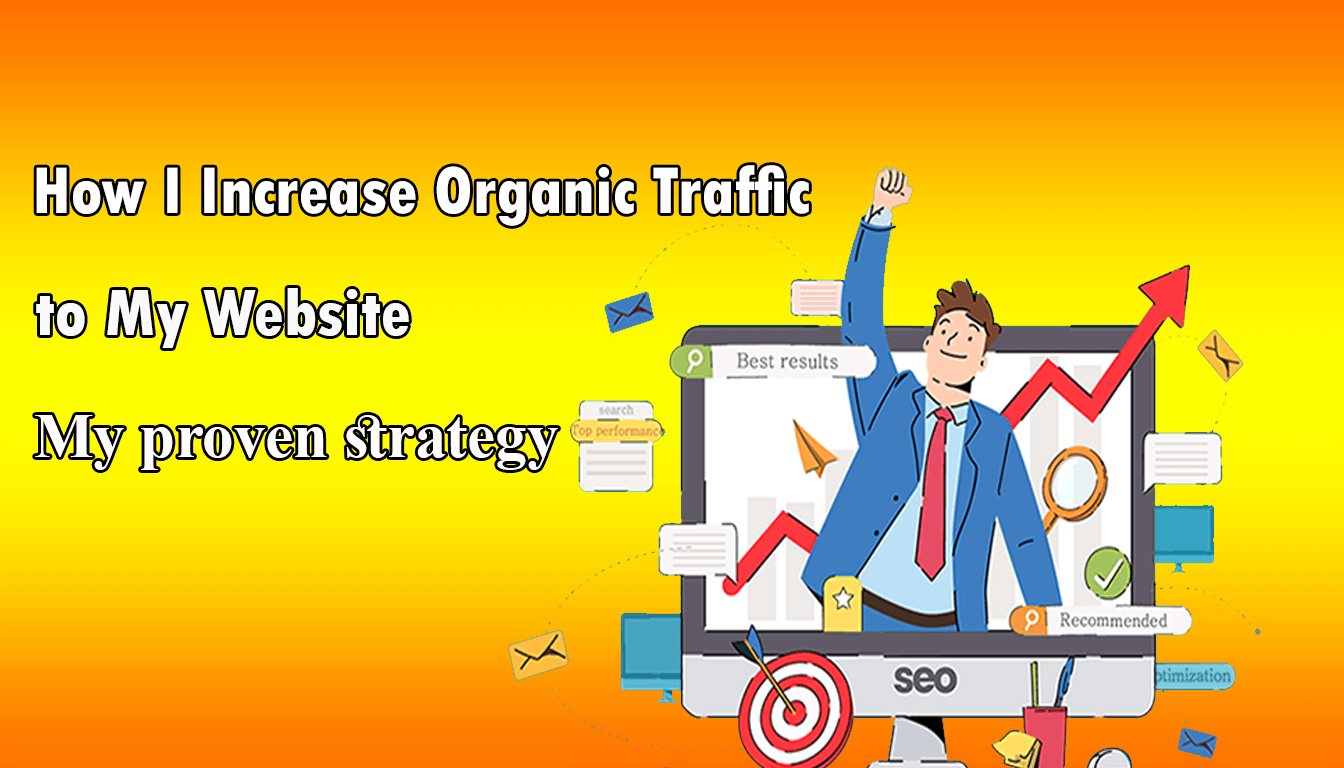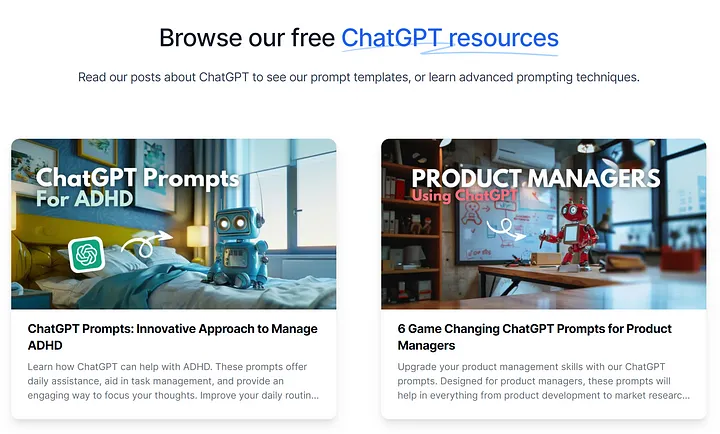From SEO Content to Useful Content: Google’s New Transition That Bloggers Search to Make
From SEO Content to Useful Content: Google’s New Transition That Bloggers Search to Make
Advice: Don't develop valuable material for SEO.

You could hardly have missed it; valuable content is what Google now wants of you.
In recent months, Google has implemented various improvements to reward sites with helpful content and limit the quantity of SEO material on Google.
A big number of sites have already experienced what occurs when Google re-evaluates their material.
After September/October 2023, I talked to website owners and observed graphs in SEO tools where 80% declines in SEO traffic were no exception. This makes it evident that helpful content has become a new pillar in SEO.
-
But how does good content compare to SEO content?
-
How do you do it?
-
And most importantly, how can you justify the investment?
SEO content versus valuable content
It’s important to point out that valuable material is distinct from the sort of content we generally write for SEO.
For simplicity, let’s call it SEO content. A lot of SEO material (to say the least) doesn’t necessarily demand the greatest work.
In my experience, certain sentences are important online to acquire a better rating for particular keywords and generate SEO visitors as rapidly as feasible.
Content marketers are frequently still focused on content, particularly the top levels of management, who regard content as something practical.
It’s not a future-proof starting point.
The fact that we develop content for SEO in this manner is not a future-proof starting point. This has to do with the fact that everything common about the most prevalent search phrases has already been mentioned on the internet.
I usually call it the apple pie effect: you may create your own recipe and believe you have unique content, but deep down it all comes down to the same stuff (apples, sultanas, cinnamon, and crust).
This is not just challenging for Google, but it’s also not optimal for consumers. Just search for anything random on Google, and you’ll get 10 sites that are mutually substitutable and interchangeable: textual material with the same content produced to rank for the same keyword.

It’s about fresh material, increased value, and effort.
Google is seeking helpful material. Content that has received time, effort, and attention.
Content that provides value to the World Wide Web, that delivers additional value compared to other sites in the search results. And where the information comes from individuals with first-hand knowledge and expertise.
Google calls the latter EEAT. It symbolizes experience, knowledge, authoritativeness, and trustworthiness. Sources with expertise and experience are recognized online as substantive authority and consequently trustworthy.

Anyone who, in addition to the beneficial content criteria, also checks the criteria for Search Quality Evaluators, a Google handbook on page quality, will discover that the term ‘effort’ occurs no less than 99 times in the text.
Google also wants us to make an effort with our material.
Just a brief observation: Can Google quantify effort?
Of course, Google can’t quantify how much time and work you put into developing your content, but sites that go beyond the apparent textual material will quickly stand out.
Think of a distinct, substantial message. But it may also incorporate other sorts of material, such as movies, small tidbits, quotations, or a helpful tool.
These are all evidence that time and effort have been spent on content. Therefore, it’s the sites with content that you don’t produce for SEO that Google looks at to achieve a higher showing.
As a side note: EEAT is not an author bio.
It’s important to note that complying with EEAT requirements is not the same as merely adding the author’s bio on your material or establishing an author page, a misconception I frequently encounter. These may be indicators of EEAT, although of course it doesn’t “make” you EEAT.
What counts is that the author and/or sender be recognized by Google as a reputable source.
It is thus vital for both the organization (sender) and the experts/authors to concentrate on their web presence.
Don’t develop valuable material for SEO.
If you want to start with valuable content, I’d like to offer you the advice not to develop it for SEO. This seems paradoxical, but I’d like to explain.
Less and less traffic from Google
There are a variety of problems at play, aside from the fierce fight in which we all strive to rank for the same search phrases on websites. For example, we know that Google is gradually “cutting” more SEO traffic.

According to SparkToro’s newest study, for every 1,000 searches, 374 individuals are still referred to websites.
Nothing new in itself, of course; we’ve known (and felt) for years that Google is gradually shutting off the tap. But at some point, this puts pressure on the economic justification for developing website content for SEO.
AI overview
So the issue is what the coming of AI overviews will entail for SEO traffic.
AI overviews are the phenomena when Google itself provides responses in search results with its own AI. Below is an example:
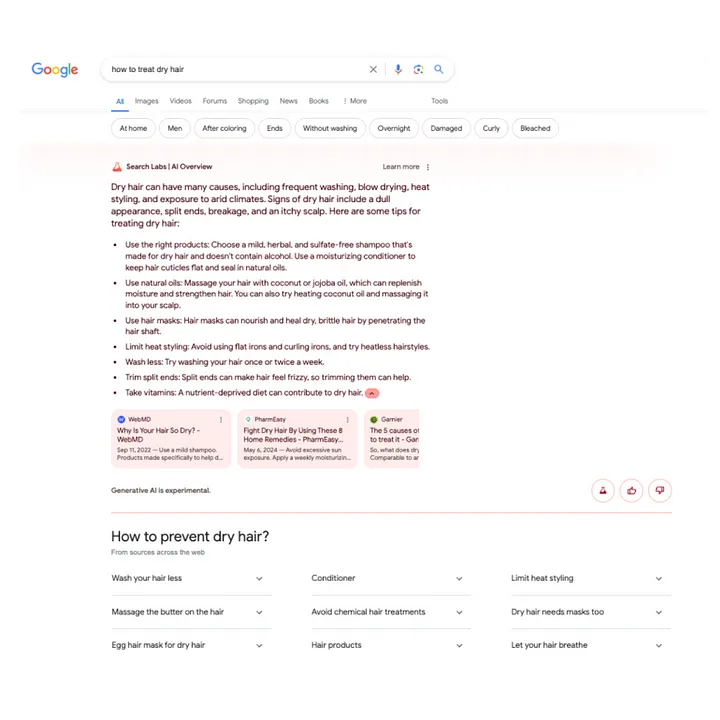
One probable result is that the sites indicated in this response will have a greater CTR, while sites outside this one will have an even lower CTR than is now the case.
But for now, this is still mostly a question of observing the coffee grounds. It’s worth keeping in mind that this may be the umpteenth time that sites lose SEO traffic and that the business case could get even more strained.
Warning!
I’m obviously not talking about the entire loss of SEO traffic; I’m talking about the balance between investment and the likely drop in the number of visitors.
Do you still need to create content?
You may ask why you would continuously develop content if there is less and less traffic... Very simple: there is still traffic, and without content, you can’t engage with your prospective consumer online, on any channel.
Useful content: look beyond your website
I would thus recommend you explore beyond the textual content of your website from now on. In part, this has to do with justifying the expenditure involved with good material (see below), but there are still a few factors at risk.
This way we all become more visual. Personally, I trust a video where I see someone using the goods more than a text-only webpage.
But most significantly, there are many more chances to get visible on Google than simply your website and connected pages.
YouTube videos are not new, but I see them in search results far more regularly than previously. Short videos from YouTube, TikTok, Facebook, and Instagram are also increasingly accessible on Google.
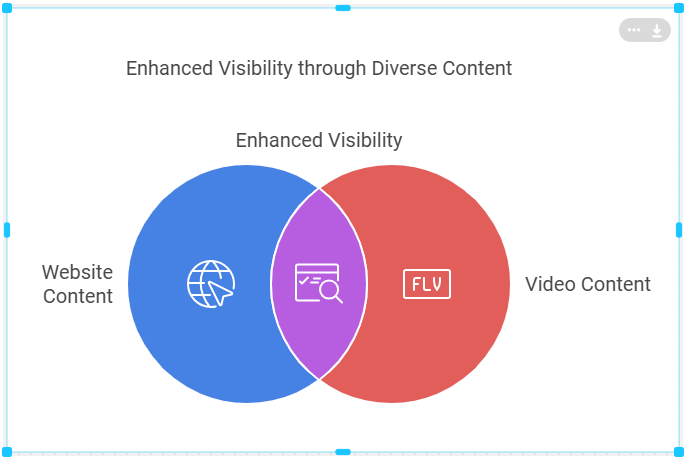
I’ve noticed with customers that there are search phrases for which it’s simpler to rank with a YouTube video or short film than with a web page, but that’s beside the point.
The puzzle: where are the opportunities?
If we put it all together, we’ll see:
-
Google aims to display websites with meaningful information that demonstrates effort and EEAT.
-
New aspects are surfacing on Google, such as short films.
-
For certain search phrases, it’s simpler to rank with a YouTube video or short film than with your website.
-
Many sites say the same thing and are consequently substitutable; competition is severe.
-
Fewer and fewer clicks go to websites; therefore, we have to embrace a wider strategy than textual material on your site.
If you put these parts of the jigsaw together, it becomes evident where the possibilities lie. For me, it’s in the field of experts, videos, and other platforms that rank on Google.
I’m a huge supporter of the technique where you generate video content in partnership with professionals. This enables you to kill numerous birds with one stone.
Warning!
Want more marketing tips and tricks? Subscribe to the Adam Pennell newsletter, Click here.
This is a different method than when you get your written material verified by specialists before publishing.
Above all, you will obtain assurance that what you have generated based on web research is not inaccurate. In my experience, everybody who gives the expert the floor receives something different in return.
The concentration specialist has a firm basis.
You have many more possibilities by recording the talk with the video expert. You may upload the film on YouTube and so rank on both YouTube and Google.
You may post shorts to your social networks with intriguing and meaningful information to get in contact with your target demographic. These shorts, in turn, may also be rated on Google. You may even post the audio, the spoken word, as a podcast, provided you examine how you record in advance.
You may then use the transcript as input for the written material you post on your site. Because let’s be honest: you still need it.
Of course, you may supplement your website with movies that reflect "effort." And it’s crucial: if people watch the videos on your website and spend time on them, they might be favorable indications for NavBoost, one of Google’s key signals.
Finally, the final point: how much attention will you receive if Google chooses to publish your YouTube video as extra material in the AI overviews? In the picture below you can see that a video by Gordon Ramsay is prominently presented.
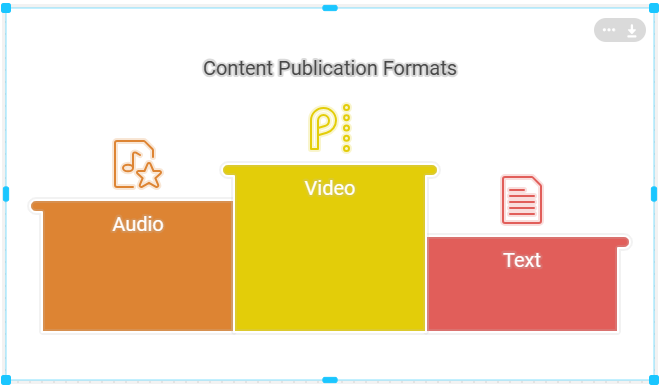
Faster using AI tools
It may seem like a lot of effort, but it’s not so awful if you approach it sensibly. Most of the labor is producing the video.
This may be a serious 15–30 minute interview with an expert, but it could also be anything else.
My initial customers are developing short videos of no more than 60 seconds, in which the product expert quickly and persuasively tells them something about topics the spectator wants to know.
Once you get the video, you may move fast and wisely with the aid of AI.
AI helps you transcribe the spoken phrase extremely rapidly, and a program like Descript now does this exceptionally effectively too. You may then utilize the transcription alone (or with the aid of ChatGPT or Claude) to generate a solid, substantial textual piece for your website.
This way, you put the AI to work on your own material, rather than living (and hence ruminating) on what the AI makes for you. You may then optimize the article for search engines.
Want more marketing tips and tricks? Subscribe to the Adam Pennell newsletter, Click here.
Reuse excerpts
You may choose the shorts manually after a lengthy film, or you can enlist the aid of an AI technology like OPUS. This program rapidly produces and subtitles numerous extracts that you may reuse.
Not everything is usable, but there are usually 4–5 fascinating pieces. A nice bonus, particularly if you also think about which snippets you can build using Descript.
That way you come full circle fast. But how do you interact with experts? How can you make time for it in your hectic schedule?
Getting the expert going
One key component is to get the expert going. In my experience, when they assist in developing material for SEO, their desire is generally little. It’s frequently a requirement.
The instant they offer an interview that you can use as a podcast and from which you can reuse parts on LinkedIn or other social networks, for example, it’s a different situation.
Now the expert has access to information in which they stand out, physically. Since I began working in this fashion, no expert has ever stated, "I don’t have time," “I can do it next month,” or “It’s still in my inbox.”.
Of course, they may utilize this information to build on their own personal brand and creative leadership.
Trap: the content
It’s vital not to speak about your goods or services in the content but on matters that worry the reader and viewer of your content.
In my experience, this is particularly a trap if you bring product managers as experts. How can you guarantee that you speak about subjects that attract your target demographic and prospective customers? I work with the QPAFFCGMIM model.
This framework may help you build fresh viewpoints that fit what the receiver wants to know. QPAFFCGMIM stands for Questions, Problems, Alternatives, Fears, Frustrations, Concerns, Goals, Myths, Interests, and Misunderstandings.
How it works
Let’s speak about something as understandable as relationship treatment. If you write anything about it without talking to a professional, you’ll probably describe what it is, when it’s beneficial, how it’s delivered, and what you’ll learn. You might seek verification from an expert who will check that what you claim is accurate.
If you do this jointly with an expert, you’ll have the possibility to learn fresh insights. Let the professional tell about concrete examples in which treatment didn’t assist and concrete cases in which it helped.
About concrete scenarios in which a relationship could no longer be rescued and concrete situations in which you are still on the correct road. This might be connected to the anxieties and worries that the seeker has.
Perhaps the expert can also tell you something about the personality and character of the clientele.
Are there some character qualities that inhibit success? And which character characteristics or attitudes are important if you wish to get started?
This might be in line with the doubts your target group has before scheduling a session.
Finally, the expert will be able to discuss cases—anonymously—which is encouraging for Google searchers seeking a solution to their difficulty on Google.
Just listen to the series of podcasts by Esther Perel, psychologist and New York Times best-selling book, a trove of rich knowledge teeming with EEAT…
It demands a new mentality and a different methodology.
You’ve already noticed that this tactic takes a different approach to what you’re accustomed to when it comes to SEO.
In this method, you don’t rapidly write a few obvious sentences based on keywords but start from your target customer’s QPAFFCGMIs. If you want to, you can, of course, always optimize the content with keywords when posting.
Another distinction is that you don’t generate the content for SEO but for all organic channels together: social media, YouTube, your website, a podcast, etc.
Create a central content department.
If you want to do a good job developing relevant material, this implies that ideally there should be a distinct content department to take care of it.
This department understands the target client inside and out, is in close communication with the channel specialists, and knows what’s happening and what’s required in terms of content and themes.
This central content department develops the essential information that is instantly helpful owing to this working technique and sends it to the channel experts who may establish a sound foundation.
The positive thing is that with this technique you don’t calculate the investment in a single channel but in the entire outcome of all the channels combined.
This method makes the investment a lot more acceptable, provides the foundations for EEAT, and implies that you have material that is actually relevant to your target client and that your organic raison d’être is larger than simply Google…
Because let’s be honest: sadly, Google gives a door-to-door guarantee.
Be sure to catch all of my stories. Subscribe to my Substack to receive free stories.
Want more marketing tips and tricks? Subscribe to the Adam Pennell newsletter, Click here.

Adam Pennell
CEO / Co-Founder
Enjoy the little things in life. It's possible that one day you'll look back and realize that they were the significant things. A significant number of persons who fail in life are those who, when they gave up, were unaware of how near they were to achieving their goals.
.webp)



